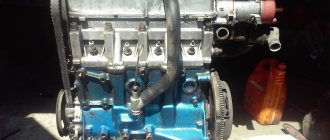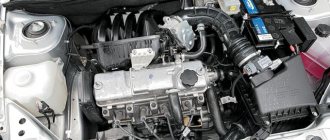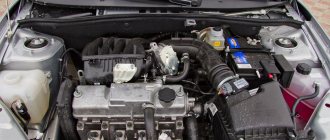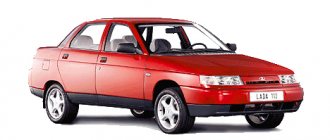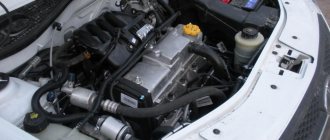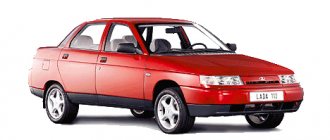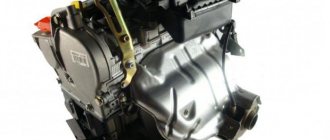The 83 series engines are the progenitor of all modern Lada engines produced today. Engine 21083 first appeared in production at the Volzhsky Automobile Plant in 1987.
This power unit had excellent fuel efficiency and provided the cars with enviable dynamics. Subsequently, on the basis of this power unit, 1.5 liter 16-valve injection engines were developed, which are currently installed on Lada cars.
Specifications
Technical characteristics of the 1.5 liter VAZ 21083 engine:
| PARAMETER | MEANING |
| Years of manufacture | 1984 – 2004 |
| Weight | 127 kg |
| Cylinder block material | cast iron |
| Supply system | carburetor |
| Type | in-line |
| Working volume | 1.5 l |
| Power | 73 horsepower at 5600 rpm |
| Number of cylinders | 4 |
| Number of valves | 2 |
| Piston stroke | 71 |
| Cylinder diameter | 82 mm |
| Compression ratio | 9.8 |
| Torque, Nm/rpm | 106 Nm / 3600 |
| Environmental standards | EURO 2 |
| Fuel | AI 93 |
| Fuel consumption | 7.8 l/100 km combined cycle |
| Oil | 5W-30 – 15W40 |
| Oil volume | 3.5 liters |
| When replacing, pour | 3.2 liters |
| The oil change is carried out | 12 thousand km |
| Engine life - according to factory data - in practice | 125+ 200+ |
The VAZ 21083 engine is installed on VAZ: 21083, 21093, 21099, 2110 and 2115.
General information
Engines of the VAZ-21081 (1100 cc), 2108 (1300 cc) and 21083 (1500 cc) models were developed specifically for the new family. In the first years, the cars were equipped with engines with an engine capacity of 1100 and 1300 cc. see. The first 54-horsepower version was exported; such cars were almost never sold within the USSR. The bulk of cars for the domestic market were equipped with a 64-horsepower engine.
All engines of the family have a high degree of unification. The differences are only in cylinder blocks (three types, have different diameters and block heights), block heads (two types, with different sections of gas channels), pistons (two types, with a diameter of 82 and 76 mm) and crankshafts (two types, elbows under different piston stroke).
The development of the most powerful 72-horsepower version of the 21083 engine dragged on for several years. But it was this option that was destined to become a long-liver and last in a modernized form on the assembly line until the present day. The 87-horsepower engine with a cylinder capacity of 1.6 liters, widely used in the products of the Volzhsky Automobile Plant, is based on the 21083 engine.
Peculiarities
- The 1.5 liter petrol engine is equipped with a carburetor power supply system and has two valves per cylinder. The power unit develops a power of 73 horsepower and at the same time has excellent fuel efficiency. On the highway, a car with a VAZ 21083 engine consumes less than 7 liters of gasoline in cruising mode.
- At the same time, it must be said that this power unit was originally designed for use on 93 gasoline. But we recommend that you avoid using low-octane fuel, as this leads to rapid failure of the carburetor and other vehicle systems.
- The upper location of the shaft in the VAZ 21083 engine made it possible to get rid of vibrations and inertial moments in the operation of the engine. This power unit has minimal vibrations, which improves the operating comfort of the vehicle.
- It must be said that the VAZ 21083 engine is equipped with a timing belt drive, so every 50,000 kilometers the car owner will need to carry out service work to replace the belt and guide rollers.
- According to the plant, the resource of the power unit is 125,000 kilometers. In practice, if proper care is provided, such engines will be able to travel more than 200 thousand kilometers without major repairs.
- Among the differences in this series of engines, we can note an increase in the piston diameter to 82 millimeters, as well as a change in the exhaust valves, which received a diameter of 37 millimeters.
- The design of the motor was designed in such a way that if the timing belt breaks, the valves do not collide with the moving pistons. Thus, it is possible to increase the reliability of the engine and relieve the car owner from the need for complex overhauls.
- The engine itself is made of cast iron, which increases the temperature stability of the power unit. The alloy used is durable and yet lightweight.
Information on the piston surface
Discussing the question of what markings on pistons mean, it is worth starting with what information the manufacturer puts on the product.
- Piston size . In some cases, in the markings on the bottom of the piston you can find numbers indicating its size, expressed in hundredths of a millimeter. Example - 83.93. This information means that the diameter does not exceed the specified value, taking into account the tolerance (tolerance groups will be discussed below; they differ for different brands of cars). Measurement is carried out at a temperature of +20°C.
- Installation gap . Its other name is temperature (since it can change along with changes in the temperature regime in the engine). Designated as Sp. It is given in fractional numbers, meaning millimeters. For example, the marking on the SP0.03 piston indicates that the gap in this case should be 0.03 mm, taking into account the tolerance range.
- Trademark . Or an emblem. In this way, manufacturers not only identify themselves, but also provide information to craftsmen about whose documentation (product catalogs) should be used when selecting a new piston.
- Installation direction . This information answers the question - what does the arrow on the piston point to? It “tells” how the piston should be mounted, in particular, the arrow is drawn in the direction of forward movement of the car. On cars where the engine is located at the rear, instead of an arrow, a symbolic crankshaft with a flywheel is often depicted.
- Casting number . These are numbers and letters that schematically indicate the geometric dimensions of the piston. Typically, such designations can be found on European machines, for which the piston group elements are manufactured by companies such as MAHLE, Kolbenschm >
In addition to these designations, there are also others, and they may differ from one manufacturer to another.
Flaws
At the same time, it should be said that this power unit is not without characteristic shortcomings. Among the problem areas we can note is the oil filter, through which oil leaks quite often appear. As a result, the motor quickly loses lubrication, begins to run dry, and soon serious problems appear.
It is also not uncommon for the distributor sensor and fuel pumps to fail. The weak point is the carburetor, which was installed on the first models of the Solex type. This power system was not particularly reliable and often failed. On later car models, the problem unit was replaced.
This power unit is characterized by increased requirements for the quality of the fuel mixture. If the first modifications of VAZ cars could easily run on 76 gasoline, then the VAZ 21083 engines quickly failed when trying to save on fuel quality. The same must be said about the quality of the service provided.
It was recommended to change the engine oil every 12-15 thousand kilometers. At the same time, work was carried out to measure compression, clean the carburetor and perform other service activities. Assembly of the VAZ 21083 engine continued until 2004, when this engine was replaced by modern 16 valve modifications.
Cars of the VAZ line using the 21083 engine
The 21083 engine was used to equip the following models of the VAZ manufacturer:
- 2108 – three-door hatchback;
- 21083 – three-door hatchback;
- 2109 – five-door hatchback;
- 21093 – five-door hatchback;
- 21099 – sedan;
- 2113 – three-door hatchback;
- 2114 – five-door hatchback;
- 2115 – sedan.
VAZ 2115
That is, the entire line of front-wheel drive cars produced before 2013 was equipped with these internal combustion engines.
Malfunctions
| FAULTS | CAUSES AND REPAIRS |
| An unpleasant knocking sound appears in the engine. | The problem may be caused by the need to adjust the valve clearance. It is recommended to perform this clearance adjustment every 50,000 kilometers. |
| The engine noticeably shakes. | It is necessary to measure the compression and, if necessary, replace the gaskets and liners. |
| The car does not start after a long period of parking. | The problem may be a dirty carburetor or electronics. In this case, the repair consists of diagnosing the car at a service station. |
| Significant increase in fuel consumption. | The reason for this may be a dirty carburetor or improper operation of the power system. |
Buy a new VAZ 2114 engine
Most often, the VAZ 11183 (21114) engine was installed on the VAZ 2114. The cost of this engine without attachment is 88,000 rubles.
If you have a different engine model, then you can find the entire available range below on the page.
If your car fails, you may need to buy an engine with 2114 8 valves or 16. All units installed by the manufacturer on this model have similar characteristics and design features. The advantages include the fact that the new injection motor is simple and easy to maintain; it can be repaired with your own hands if you really want to, if the technical condition allows it. Technical service must be carried out every 12,000-15,000 kilometers traveled. Let's consider what everyone who wants to buy a VAZ 21140 engine needs to know.
Main characteristics of the VAZ 2114 engine
Would you like to purchase an engine for a VAZ 2114? Then it’s worth considering the main properties of the units so as not to make a mistake in choosing the right one: • The volume is 1.5 and 1.6 liters, which is a standard indicator for a passenger car. • ICEs have 8 and 16 valves. • The units operate on gasoline, the injection system is a carburetor or an injector. • Power from 69 to 89.1 horsepower, each unit has its own. • For products of the domestic automobile industry, relatively low fuel consumption is noted, within 8.2 liters on average per 100 kilometers.
The price of new original equipment for the 14th LADA model is noteworthy and profitable. You can find out how much each unit costs directly on the page of the selected modification before purchasing for your five-door hatchback of the LADA Samara family. The cost varies depending on the availability of attachments and model parameters. We present all modification options that can breathe new life into your car.
We ship with a 10% prepayment throughout Russia! If you are at a loss with a choice, then write to our manager in the chat or request a call back
List of engines that can be installed on the VAZ 2114:
Engine VAZ-11183 (21114) buy new
► Cylinder block assembled with piston group and crankshaft - 52,000 rubles. ► Cylinder block assembly, cylinder head assembly, without attachments - RUB 89,000. We ship with a 10% prepayment throughout Russia!
Engine VAZ-11183 Kalina (unit)
Cylinder block assembled, cylinder head assembled, without attachments.
Engine VAZ-2111 new for VAZ 2108-099, 2110-2112, 2113, 2114, 2115 injector
► Cylinder block assembled with piston group and crankshaft - 51,000 rubles. ► Cylinder block assembly, cylinder head assembly, without attachments - RUB 80,000. We ship with a 10% prepayment throughout Russia!
Engine VAZ-21124 (unit)
Cylinder block assembled, cylinder head assembled, without attachments.
Engine VAZ-21124 buy new
Engineering, 16th grade, V=1.6l, 89.1hp, AI-95. The VAZ 21124 engine can be used for installation on VAZ 2110, VAZ 2111, VAZ 2112 cars and their modifications. We send engines to TK with 10% prepayment
Engine for VAZ-21083, 2109, 21093, 21099, 2113, 2114, 2115 (carburetor) new buy
► Cylinder block assembled with piston group and crankshaft - 51,000 rubles. ► Cylinder block assembly, cylinder head assembly, without attachments - RUB 65,000. We ship with a 10% prepayment throughout Russia!
We deliver throughout Russia and Kazakhstan by transport companies
List of delivery cities
Abakan Adler Almetyevsk Angarsk Apatity Arzamas Armavir Arkhangelsk Asbest Astrakhan Achinsk Balakovo Balashikha Barnaul Belgorod Beloretsk Berdsk Berezniki Biysk Blagoveshchensk Borisoglebsk Borovichi Bratsk Bryansk Buzuluk Velikiye Luki Veliky Novgorod Vladivostok Vladikavkaz Vladimir Volgograd Volgodonsk Volzhsky V ologda Vorkuta Voronezh Voskresensk Votkinsk Vsevolozhsk Vyborg Gatchina Glazov Gorelovo Grozny Dzerzhinsk Dimitrovgrad Dmitrov Domodedovo Yeysk Ekaterinburg Zheleznodorozhny Zabaikalsk Zelenograd Zlatoust Ivanovo Izhevsk Irkutsk Yoshkar-Ola Kazan Kaliningrad Kaluga Kamensk-Uralsky Kamensk-Shakhtinsky Kamyshin Kachkanar Kemerovo Kerch Kirov Kirovo-Chepetsk Klin Klintsy Kovrov Kolomna Kolpino Komsomolsk-on-Amur Kostroma Kotlas Krasnogorsk Krasno dar Krasnokamsk Krasnoyarsk Kuznetsk Kumertau Kurgan Kursk Leninsk -Kuznetsky Livny Lipetsk Magnitogorsk Maykop Makhachkala Miass Moscow Murmansk Murom Mytishchi Naberezhnye Chelny Naro-Fominsk Neftekamsk Nizhnevartovsk Nizhnekamsk Nizhny Novgorod Nizhny Tagil Novokuznetsk Novomoskovsk Novorossiysk Novosibirsk Novocheboksarsk Novocherkassk Novy Urengoy Noginsk Noyabrsk Obninsk Odintsovo Oktyabrsky Omsk Orel Orenburg Orekhovo-Zuevo Orsk Penza Pervouralsk Perm Petrozavodsk Podolsk Pskov Pushkin Pushkino Pyatigorsk Roslavl Rossosh Rostov-on-Don Rybinsk Ryazan Salavat Samara St. Petersburg Saransk Saratov Sevastopol Severodvinsk Sergiev Posad Serov Serpukhov Simferopol Smolensk Solnechnogorsk Sosnovy Bor Sochi Stavropol Stary Oskol Sterlitamak Stupino Surgut Syzran Syktyvkar Taganrog Tambov Tver Tobolsk Togliatti Tomilino Tomsk Tula Tyumen Ulan- Ude Ulyanovsk Usinsk Ussuriysk Ust-Kut Ufa Ukhta Khabarovsk Khanty-Mansiysk Tchaikovsky Cheboksary Chelyabinsk Cherepovets Chekhov Chita Mines Sheremetyevo Engels Yaroslavl
Tuning
There are several common options for increasing the power of the VAZ 21083 engine:
- For example, it is possible to replace the camshaft with a sports modification. At the same time, lightweight gears are installed, which allows the engine power to be increased to 80 horsepower. Similar tuning of the VAZ engine when modifying the intake manifold, cylinder head and valves allows you to get an additional 10 horsepower.
- An alternative option for tuning a VAZ engine is to install a compressor. In this case, it is recommended to replace the carburetor power system with an injector and use a small-capacity compressor. The power of such a power unit can be 100-120 horsepower. Just remember that such tuning and engine assembly should be performed exclusively by an experienced specialist, which guarantees the performance of the car’s engine.
Maintenance
The classic internal combustion engine design in combination with a transverse engine arrangement under the hood of front-wheel drive cars is subject to the following maintenance regulations:
| Maintenance object | Time or mileage (whichever comes first) |
| Timing belt | replacement after 100 thousand km |
| Battery | 12 months/20 thousand km |
| Valve clearance | 24 months/20 thousand km |
| Crankcase ventilation | 24 months /20 thousand km |
| Belts that drive attachments | 24 months /20 thousand km |
| Fuel line and tank cap | 24 months /40 thousand km |
| Motor oil | 12 months/10 thousand km |
| Oil filter | 12 months/10 thousand km |
| Air filter | 21 – 24 months /40 thousand km |
| Fuel filter | 48 months/40 thousand km |
| Heating/Cooling Fittings and Hoses | 24 months /40 thousand km |
| Coolant | 24 months /40 thousand km |
| Oxygen sensor | 100 thousand km |
| Spark plug | 12 – 24 months /20 thousand km |
| Exhaust manifold | 12 months |
The accompanying instructions contain a description of the parameters; the manufacturer strongly recommends following the maintenance procedure for engines 21083.
Repair
Repairing a VAZ 21083 engine with your own hands is quite simple. The main thing is to know the cause of the breakdown. Many owners of cars with a well-known engine have encountered common problems over the years. Thanks to this, it was possible to identify the main symptoms of impaired engine operation and find measures to get rid of them:
- Unpleasant knocking is often the cause of changes in valve clearance. Adjustments are made every 50 thousand km.
- The engine starts to stall. With such a symptom, it is worth measuring the compression.
- The car will not start after being parked for a long time. The reason often lies in electronics. The repair measure is to diagnose the car at a service station.
- Fuel consumption has increased - often this malfunction is the result of carburetor contamination.
Repairing the VAZ 21083 engine in service centers is quite simple due to the high prevalence of the car in Russia.
1 — generator drive pulley; 2 – oil pump; 3 – timing belt; 4 – toothed pulley of the coolant pump; 5 – front cover of the timing mechanism drive; 6 – tension roller; 7 – camshaft toothed pulley; 8 – rear cover of the camshaft drive; 9 – camshaft oil seal; 10 – cylinder head cover; 11 – camshaft; 12 – front cover of camshaft bearings; 13 – pusher; 14 – valve guide; 15 – oil separator mesh for the crankcase ventilation system; 16 – exhaust valve; 17 – inlet valve; 18 – rear cover of camshaft bearings; 19 – fuel pump; 20 – housing of auxiliary units; 21 – ignition distributor sensor; 22 – outlet pipe of the cooling jacket; 23 – cylinder head; 24 – spark plug; 25 – crankcase ventilation hose; 26 – flywheel; 27 – crankshaft rear oil seal holder; 28 – rear crankshaft oil seal; 29 – cylinder block; 30 – oil pan; 31 – oil level indicator (oil dipstick); 32 – crankshaft; 33 – piston; 34 – connecting rod cover; 35 – connecting rod; 36 – crankshaft main bearing cover; 37 – front crankshaft oil seal; 38 – crankshaft toothed pulley.
1 – oil pan drain plug; 2 – oil pan; 3 – oil filter; 4 – coolant pump; 5 – exhaust manifold; 6 – intake manifold; 7 – carburetor; 8 – fuel pump; 9 – cylinder head cover; 10 – camshaft bearing cover; 11 – camshaft; 12 – crankcase ventilation hose; 13 – valve adjusting washer; 14 – pusher; 15 – valve cotters; 16 – valve springs; 17 – oil deflector cap; 18 – valve guide; 19 – valve; 20 – cylinder head; 21 – spark plug; 22 – piston; 23 – compression piston rings; 24 – oil scraper ring; 25 – piston pin; 26 – cylinder block; 27 – connecting rod; 28 – crankshaft; 29 – connecting rod cover; 30 – oil level indicator; 31 – oil receiver.
Gasoline, four-stroke, four-cylinder, eight-valve, in-line, overhead camshaft. The power supply system is with a carburetor. Cylinder operating order: 1–3–4–2, counting from the crankshaft pulley. The engine with the gearbox and clutch forms the power unit - a single unit mounted in the engine compartment on three elastic rubber-metal supports.
On the right (along the direction of the car) on the engine are located: drives for the camshaft and coolant pump (by a toothed belt) and a generator (by a V-belt). On the left are: ignition distributor sensor (distributor), thermostat, coolant temperature sensor, starter (on the clutch housing). Front: spark plugs and high voltage wires, oil dipstick, crankcase ventilation hose, generator (lower right). Rear: intake and exhaust manifolds, oil filter; as well as the fuel pump, carburetor and air filter housing (at the top).
The -21083 engine became the basis for the -2111 engine, so they have the same cylinder block, crankshaft, and cylinder head. The connecting rod-piston group is different: in the -21083 engine, the pin is not with a loose fit and retaining rings, as in the -2111 engine, but is pressed into the upper head of the connecting rod. If connecting rod-piston group -21083 is missing, group -2110 can be installed.
Power unit overheating
Trouble happened on the way
Many owners of VAZ Samara cars complain that the engine gets very hot. This situation is especially often observed in the southern regions of our country. There can be many reasons for this phenomenon, and not all of them are related to the cooling system.
VAZ engine operating temperature °C. The radiator fan should turn on at 101 - 105°C. The engine gets hot mainly for 6 reasons.
- There are air pockets in the liquid cooling system (coolant).
- The coolant system is filled with low-quality antifreeze.
- The radiator fan switch sensor is faulty.
- The thermostat is not working.
- The crankcase ventilation system is dirty.
- The connecting rod and piston group is severely worn.
Regardless of the identified cause of the problem, the following measures must be taken.
- Drain the old coolant.
- Flush the coolant system.
- Check the tightness of the system, including the expansion tank cap.
- If minor leaks are found, repair them.
- Check the functionality of the thermostat. If necessary, replace it.
- Make sure the fan switch and coolant temperature sensor are working properly. Replace them if necessary.
- Blow out the crankcase ventilation system with compressed air.
- Fill with new, high-quality antifreeze.
If after all these procedures the engine gets very hot again, get ready for a major overhaul.
